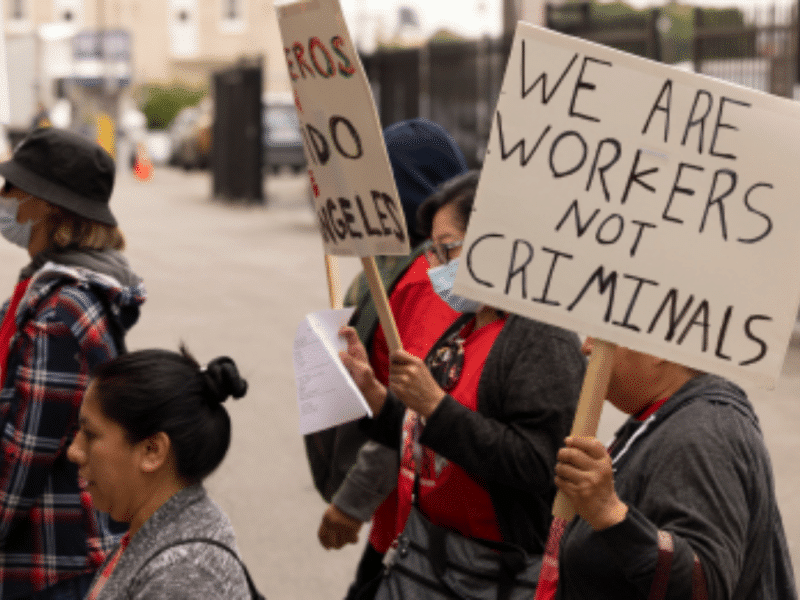Arizona Supreme Court Says 1864 Abortion Law is Constitutional, Joining Florida in Further Decimating Women’s Rights
The Arizona Supreme Court has catapulted the state back to the 1860s, imposing a near-total abortion ban that obliterates reproductive rights.

The landscape of abortion rights in the United States has become more restrictive than ever in recent history, particularly in Arizona and Florida, where recent developments represent a major setback for women’s reproductive rights. On April 9, the Arizona Supreme Court ruled in a 4-to-2 decision to uphold an 1864 law banning abortion from the moment of conception. The only exception is saving the mother’s life, but there are no exceptions for rape or incest under this law.
Just a few days earlier, on April 1, the Florida Supreme Court also ruled in favor of upholding a 6-week abortion ban, which will take effect on May 1. This further reduced the legal threshold for abortions in Florida, which used to be 24 weeks of pregnancy before Republicans passed a law in 2022 banning abortions after 15 weeks. Both of these rulings have sparked intense debate and outrage about their impact on women’s rights.
Overview of the Near-Total Abortion Ban in Arizona
Medical professionals have spoken out about how dire the situation will become for women with this near-total abortion ban. Dr. Jill Gibson, chief medical director of Planned Parenthood in Arizona, told CNN that this ruling will have “absolutely unbelievable consequences for the patients in our community.” She continued by saying, “Providers need to be able to take care of their patients without fear of legal repercussions and criminalization.”
Representatives from Arizona and other states across the country have also spoken up against this near-total abortion ban.
Video by Shontel Brown Member of the United States House of Representatives on InstagramVideo by Shontel Brown Member of the United States House of Representatives on Instagram

Image by Rubén Gallego Member of the United States House of Representatives on InstagramImage by Rubén Gallego Member of the United States House of Representatives on Instagram
Until this Arizona Supreme Court decision, abortion had been legal in the state up to 15 weeks of pregnancy. The right to abortion via Roe v. Wade prevented the enforcement of the near-total abortion ban, but since a majority vote in the Supreme Court of the United States overturned Roe, those opposed to abortion rights had been fighting to enforce the 160-year-old 1864 law.
This new abortion ban in Arizona is not effective immediately as the court has paused its ruling for 14 days until additional arguments are heard in a lower court about how constitutional the law is. However, the law will likely come into effect in May, a few weeks from now. Planned Parenthood Arizona, the largest abortion provider in the state, will continue serving the community until the ban is enforced.
An Overview of Florida’s Six-Week Abortion Ban
The landscape of abortion in Florida has also undergone a significant change with the enforcement of a 6-week abortion ban, replacing the previous 15-week limit. This ban, similar to Arizona’s, severely restricts access to abortion care and poses a significant challenge to reproductive rights in the state. Providers are bracing for a public health crisis due to the increased demand for abortion and limited options for patients.
Practically speaking, a 6-week abortion ban is a near-total abortion ban because pregnant people often don’t even realize they could be pregnant by this early stage. Combined with Florida’s strict abortion requirements, which include mandatory in-person doctor visits with a 24-hour waiting period, it’s nearly impossible for those who may want an abortion to be able to access it before 6 weeks. Not to mention that fulfilling the requirements is particularly challenging for low-income individuals.
Video by theluncheonlawyer on InstagramVideo by theluncheonlawyer on Instagram
Moreover, this Florida law also restricts telemedicine for abortion and requires that medication be provided in person, effectively eliminating mail-order options for abortion pills. While exceptions for rape and incest exist in Florida, the requirements are also strict, asking victims to provide police records or medical records. For victims who don’t always report sexual violence for many different reasons, these exceptions don’t make a difference.
The consequences of Florida’s ban extend to neighboring states with more restrictive abortion laws. For instance, residents of Alabama, facing a total ban on abortion, and Georgia, with its own 6-week abortion ban, have relied on Florida for abortion services. That will no longer be an option, further limiting care alternatives.
The Road Ahead
These recent abortion bans in Arizona and Florida are a major setback for women’s rights, particularly impacting Latina women who already face barriers to accessing quality healthcare. These bans not only restrict women’s reproductive freedom but also endanger their lives.
Efforts to challenge these bans through legal means and ballot measures are ongoing, but the road ahead is uncertain. While there’s hope for overturning these abortion bans, the challenges of conservative laws and legal battles are formidable. The November ballot in both states will be crucial in determining the future of abortion rights and access for all.




